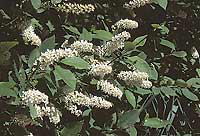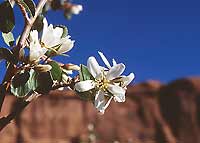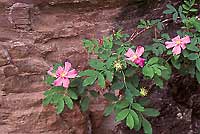…is a rose. Gertrude Stein wrote that simple yet famous line in the poem “Sacred Emily” in 1913. She wasn’t referencing cultivated or wild-growing roses but, still, the line holds true for Rose family members that bloom in this red rock desert.
There is a lot of variation on the rose theme here. Chokecherries, cliffrose, Woods’ rose, and rockmat (Petrophytum caespitosum), a low-growing perennial are very different from one another but all share some common floral characteristics. 
Rose flowers are radially symmetrical, called actinomorphic, bearing 5 petals and 5 sepals and often numerous stamens. The bases of these floral parts are fused together along the rim of a floral cup called the hypanthium. This cup surrounds and protects the plant’s nectar-producing glands which entice pollinators to the flower.
With over 3,000 members in the mid-sized Rose family, you’re never very far from a wild rose while out exploring the desert.
Chokecherries (Prunus virginiana) is a small to mid-sized tree that blooms in late spring and summer, bearing a wand of white, fragrant flowers which bear dark red to black “berries.” The fruits are called “drupes,” with a fleshy coating encasing a hard seed (think like a peach). The seeds are toxic, although Native Americans used to harvest the fruits and crush them up, seeds and all, and add the mix to make pemmican. North Dakota honored chokecherries designating them at their State Fruit due to the high rate of chokecherries being found in statewide archaeological sites. The trees prefer moist canyon bottoms for growing.
In contrast to the riparian chokecherry, several shrubs grow in the drier portions of Canyon Country including blackbrush, cliffrose, mountain mahogany, Utah serviceberry (Amelanchier utahensis), and antelope bitterbrush.
Blackbrush (Coleogyne ramosissima) are easily overlooked shrubs during most of the year, except for when their yellow flowers cloak the plant. Vast swaths of blackbrush-dominated shrublands exist in the region and these plants, like their relatives the antelope bitterbrush (Purshia tridentata), are important winter forage for mule deer and other species.
Like the bitterbrush, when cliffrose (Purshia mexicana) bloom an unmistakable aroma perfumes the desert air. The sweet-smelling flowers attract insect pollinators, bees in particular. Unlike the fleshy fruits of chokecherries, a cliffrose flower produces a hard seed which bears a long feathery tail. When the seed falls to the ground, the pointed end embeds in the ground and then the wind twists the tail like a corkscrew, auguring the seed into the soil. Other cliffrose relatives, in the mountain mahogany genus (Cercocarpus), employ this same tactic. Cercocarpus is from the Greek words kerkos (tail) and carpos (fruit) referring to this feathery tail.
 Woods’ rose (Rosa woodsii) is another variation of the rose theme, with beautiful flowers which produce a fleshy rose hip. The shrub is named for Joseph Woods (1776-1864), an English architect who devoted himself to botanizing in Europe and writing about British roses, not the plant’s woodland habitat.
Woods’ rose (Rosa woodsii) is another variation of the rose theme, with beautiful flowers which produce a fleshy rose hip. The shrub is named for Joseph Woods (1776-1864), an English architect who devoted himself to botanizing in Europe and writing about British roses, not the plant’s woodland habitat.
No matter where one travels in the desert, some member of the Rose family is sure to be nearby. Like Stein, Shakespeare wasn’t referring to those wild English roses when he wrote in Romeo and Juliet, “A rose by any other name would smell so sweet,” but it’s an applicable line for these sweet-smelling plants that grace our landscape.blackbrush-.



 Woods’ rose (Rosa woodsii) is another variation of the rose theme, with beautiful flowers which produce a fleshy rose hip. The shrub is named for Joseph Woods (1776-1864), an English architect who devoted himself to botanizing in Europe and writing about British roses, not the plant’s woodland habitat.
Woods’ rose (Rosa woodsii) is another variation of the rose theme, with beautiful flowers which produce a fleshy rose hip. The shrub is named for Joseph Woods (1776-1864), an English architect who devoted himself to botanizing in Europe and writing about British roses, not the plant’s woodland habitat.